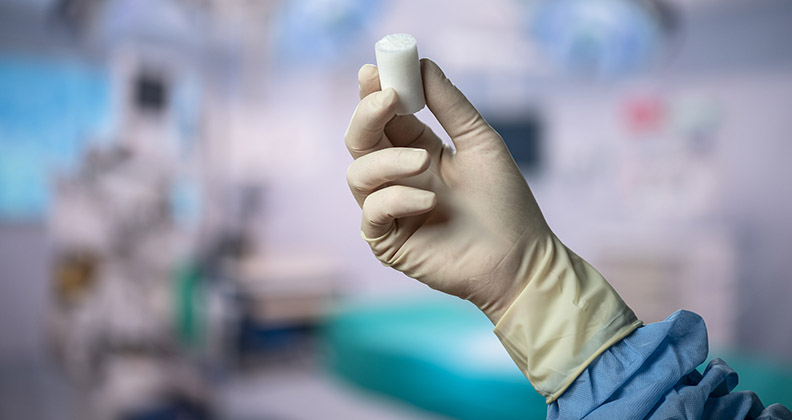
Surgeons, company leaders and industry insiders from around the world convened in San Francisco last week for the American Academy of Orthopaedic Surgeons Annual Meeting. It was a fun and productive time as we talked with top physicians, met with company execs and listened in as presenters discussed the latest developments in orthopedic care. Three key trends emerged during a busy week spent in education sessions, the exhibit hall and networking receptions.
AI on the Horizon
The President’s Symposium drew a standing-room-only crowd on the conference’s second day as attendees packed a session room to learn about generative AI’s potential in healthcare.
Prakash Jayakumar, M.D., Ph.D., introduced the panel discussion by acknowledging that the advent of AI has sparked intense debate and speculation around the hope and the hype behind the breakthrough technology.
“While rapid innovations in AI emerge, so do questions about the biases of information, ensuring data remains protected and the risk versus reward of how we deliver health and healthcare benefit to our patients,” said Dr. Jayakumar, Assistant Professor of Surgery and Director of Value-based Healthcare and Outcome Measurement at Dell Medical School, University of Texas at Austin.
Deep learning is driving a lot of the advancement in AI and allows platforms to learn complex associations between two outcomes without assumption, according to panelist Justin Krogue, M.D., Assistant Professor of Orthopaedic Surgery at the University of California, San Francisco and Clinical Scientist in Health AI at Google.
He said that providing deep learning AI platforms with pelvic x-rays of hip fractures and non-hip fractures would allow the technology to match the performance of an expert in identifying hip fractures. “This would allow for diagnosis and triage,” Dr. Krogue said. “But you could also use AI to automate tasks and predict outcomes in ways that humans can’t currently do.”
Joseph H. Schwab, M.D., F.A.A.O.S., Director of Spine Oncology and Director of the Center for Surgical Innovation and Engineering at Cedars-Sinai Hospital in Los Angeles, preached caution when it comes to implementing AI. “When things go wrong, they’ll continue to go wrong,” he said. “We’ve got to work through that truth before AI becomes something that we can use in healthcare.”
Dr. Schwab referred to Chris Anderson, former editor of Wired Magazine, who infamously said that with enough data, the numbers speak for themselves. “This is categorically untrue,” Dr. Schwab explained. “There are a lot of problems with that level of thinking.”
For one, data is imbued with a historical pattern. “Is that always an issue?” Dr. Schwab asked. “No, we often want historical patterns in data to reflect what has occurred in society. However, some historical patterns impact the accuracy of data, and we don’t want them to be contained within AI algorithms. A well-meaning algorithm can be problematic because the data are biased and don’t represent what we truly need to know.”
That doesn’t mean healthcare should ignore AI’s potential, Dr. Schwab noted. “There are going to be problems we need to work through, and we shouldn’t necessarily embrace some large language models at scale until we figure them out,” he said. “But we will figure them out, and they will be our partners in patient care in the future.”
Improved Healing Powers
Anika Therapeutics’ product portfolio includes the Integrity Implant System, comprising an HA-based implant that is fixated using PEEK bone staples, resorbable PLGA tissue tacks or suture fixation at the site of rotator cuff augmentation. The company received FDA 510(k) clearance for the platform technology and plans to develop a pipeline of products with regenerative properties, according to Cheryl Blanchard, Ph.D., Anika’s CEO.
Dr. Blanchard is excited about the rapid growth of its single-stage cartilage repair product, which is currently available in more than 30 countries outside the U.S. Anika has a fully enrolled clinical trial in the U.S. which is anticipated to begin in early 2025, and plans to file a modular Premarket Approval for the product later this year. This off-the-shelf single-stage solution streamlines the administration process, requiring only one surgery to deliver it to the joint.
“With over 40 clinical publications supporting its efficacy, we’re entering the U.S. market armed not only with domestic trial data but also with 15 years of international experience,” Dr. Blanchard said. “While launching a product with 15-year data may be unconventional in the U.S., the product has a strong international track record.”
Anika’s offerings also include Tactoset, an injectable, settable bone void filler primarily used to address insufficiency fractures. Tactoset can also be used to augment hardware placement, particularly in challenging cases involving suture anchors placed in low-quality bone.
“Injecting Tactoset before placing a suture anchor doubles the retention strength,” Dr. Blanchard said. “This is particularly beneficial in shoulder procedures and frequently utilized in foot and ankle applications. Our focus now is on further developing our regenerative portfolio in a market we have a right to win.”
Dr. Blanchard said increasing numbers of patients are interested in regenerative and early intervention therapies. For example, she cited the company’s single-injection, next-generation osteoarthritis pain management product, which combines hyaluronic acid with a steroid. It’s currently available in over 35 countries, and Anika is engaged in discussions with FDA to introduce it to the U.S. market.
“This trend aligns perfectly with our focus on solutions designed for repairs of cartilage, soft tissue and bone,” Dr. Blanchard said.
Nathan Skelley, M.D., a sports medicine specialist at Sanford Health, stopped by the CONMED booth to learn more about BioBrace, a bovine/collagen bioinductive implant that provides mechanical strength and biologic healing potential during joint repair surgery. “The results are encouraging,” he said. “They show the value-add of augmenting mechanical repairs with new technologies that are pushing the envelope and improving patient outcomes.”
Dr. Skelley said Arthrex has made significant strides with platelet-rich plasma (PRP) and bone marrow aspirate concentrate (BMAC) systems for hip core decompression surgery. He also cited MTF Biologics’ CartiMax, a putty that’s used to help fill cartilage defects in the knee.
“The putty is simple to use and grows hyaline-like cartilage,” he said. “Hopefully, we’ll soon be able to apply the putty arthroscopically. That would be a great advancement in the knee repair space over the next few years.”
Enabling Technology Advances
THINK Surgical, which is committed to providing surgeons with open-platform surgical robots that support implants from multiple manufacturers, announced collaborations with Waldemar Link, Maxx Orthopedics and b-ONE Ortho Corporation. The companies’ knee replacement implant systems will be added to THINK Surgical’s proprietary data bank of implant modules for use with the TMINI Miniature Robotic System.
Zimmer Biomet (ZB) had its new robotic shoulder application on-site and available for controlled surgeon demos. ZB wants to assess a predefined menu of items, such as surgical workflow and positioning within the surgical field, as consulting surgeons begin using the robot during live cases. The company will build off that feedback for a broader launch that’s expected later this year.
ZB will soon launch version 2.0 of the Signature ONE 3D-based surgical planning tool, which allows surgeons to tailor approaches to the unique anatomy of individual patients. The upgraded Signature ONE will be embedded with the company’s flagship Identity Shoulder System, giving surgeons the ability to assess Identity’s humeral construct and conduct a 3D analysis of the joint’s range of motion to determine which implant would be the best fit in specific patients.
“Shoulder replacement volumes are growing by around 8%, and I don’t see that slowing down,” said Nnamdi Njoku, President of Sports Medicine, Surgical, Upper Extremities & Restorative Therapies at Zimmer Biomet. “I think enabling technology will spur a lot of that growth. Half of the ZB implants are planned in the Signature One platform, leading to personalized surgery that will help to grow shoulder replacement efficacy and interest in the procedure.”
ZB is expected to launch a stemless application of Identity, which will spare more bone in active patients, according to Njoku. “Materials, technology and surgical techniques are getting better,” he said. “Patients are becoming more aware that they don’t need to live with shoulder pain and are opting to undergo surgery sooner.”
Navigation is typically associated with robotics and arthroplasty, but the technology has been a game-changer for Dr. Skelley’s hip arthroscopy practice. He said Stryker’s OrthoMap hip navigation software provides 3D models of joint anatomy, which he uses to determine where bone impingement or torsional alignment of the hip will occur.
“The information gives me and my surgical team a wealth of knowledge that has completely changed how I perform surgery,” Dr. Skelley said. “Instead of a standardized approach, I’m able to adjust my technique based on the identified needs of individual patients. Anecdotally, outcomes are better now that I can target specific pathology.”
Data-driven care will allow care teams to follow various types of patients for extended periods to track the factors that result in good outcomes, according to Bill Hunter, M.D., President and CEO of Canary Medical. He said matching intraoperative data captured by surgical robots or smart implants with machine learning might lead surgeons to change how they place specific implants in certain kinds of joint anatomy.
“Using captured data to inform implant design and surgical technique will get us closer to personalized medicine,” Dr. Hunter said.
He believes the reams of data currently being collected by smart implants and robotic platforms will allow physicians and care teams to screen patients and identify potential adverse outcomes sooner than what’s currently possible.
“The earlier the diagnosis, the higher the probability of administering a curative intervention instead of a palliative intervention,” Dr. Hunter said. “What excites me is the ability to conduct continuous monitoring and early interventions to prevent, for example, implant-associated infections. That’s a $120,000 problem, necessitating a two-stage revision that’s terrible for patients, surgeons and the healthcare system.”
Dr. Hunter is energized by the progress he saw on the exhibit hall floor. “When you add data to all this incredible engineering, some pretty cool stuff is going to happen,” he said. “I truly believe we’re entering the golden era of medicine.”
He referred to Google founder Eric Schmidt, who once wondered what infinite computing power could do for businesses. “Well, here we are,” Dr. Hunter said. “What that will do in orthopedics will be breathtaking.”
DC
Dan Cook is a Senior Editor at ORTHOWORLD. He develops content focused on important industry trends, top thought leaders and innovative technologies.




